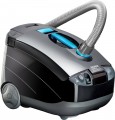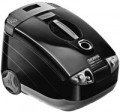Dust collector
The type of dust collector provided in the design of the vacuum cleaner.
Nowadays, there are three main types of dust collectors — a regular
bag,
a cyclone system and an
aquafilter. Also, in some vacuum cleaners (in particular, industrial and fireplace models — see "Product type") dust collectors in the form of rigid containers (tanks) can be used without additional equipment. For such models, the type of dust collector in our catalogue is not specified. As for the three main types, here are their features:
— Bag. A dust collector in the form of a soft bag, simultaneously plays the role of one of the filters: air passes through the walls of the bag, and most of the contaminants are retained. Such containers are simple and inexpensive, while they can be made quite roomy. In addition, the vacuum cleaner with a bag remains operational in any position of the body. On the other hand, as the bag fills up, suction efficiency drops noticeably; and the cleaning procedure is usually quite troublesome — in particular, a lot of dust is raised into the air. Disposable bags, which are available for many models as an additional accessory, are deprived of such a drawback. However, on the other hand, the purchase of such bags is associated with additional expenses. As a result, this type of dust collector, although very popular in modern vacuum cleaners, is much less common
...than the "cyclones" described below.
— Cyclone system (bagless). Dust collector based on a cyclone type air cleaner; usually has the form of a plastic bowl of a special shape. The principle of operation of such systems is that the air flow entering the dust collector is twisted into a spiral. In this case, the centrifugal force throws debris and dust out of the formed vortex, and the collected pollution sinks to the bottom of the dust collector. One of the main advantages of "cyclones" is the ease of cleaning: just turn the container over and the contents pour out of it without additional effort, and if desired, the dust collector can be easily washed. In addition, the suction force is practically independent of the degree of filling of the bowl. However, cyclones are somewhat inferior in capacity to bags, but because of the foregoing, this point is usually not fundamental. But the unequivocal disadvantages of this option are the higher cost of the same bags; a lower suction force for the same engine power; as well as a somewhat lower efficiency of catching fine dust. In light of the latter, "cyclones" have to be equipped with additional filters, which also periodically require cleaning. It is also worth bearing in mind that such systems are most effective with a regular, strictly defined position in space. If you deviate from this standard operational position, the efficiency of the dust collector may noticeably decrease, which leads to rapid clogging of the filters.
— Aquafilter. This type of dust collector looks like a container with water: the air drawn in by the vacuum cleaner passes through the liquid, which traps most of the contaminants. Such systems are highly efficient and hygienic: they capture various contaminants well, including even fine dust, without additional filters. In addition, the air released by the vacuum cleaner is additionally humidified which is especially useful in the cold season, when heating dries the air in the room. At the same time, the procedure for cleaning the dust collector itself is very simple and convenient: after cleaning, its contents can simply be poured into the sewer, while no dust rises into the air (unlike the process of cleaning cyclones and especially bags). On the other hand, it is desirable to wash and dry aquafilters after each use, which somewhat complicates maintenance. In addition, most of these vacuum cleaners are quite expensive, the passage of air through the water creates additional noise, and the water itself significantly increases the weight of the unit.
Separately, it is worth emphasizing that the presence of an aquafilter does not mean that the vacuum cleaner is washing (see above) or at least can wet cleaning (see "Cleaning type"). Quite a few models with an aquafilter work only in a dry format — and vice versa, units with a wet cleaning function may well be equipped with other types of dust collectors.
— Aquafilter + bag. This option means that the vacuum cleaner is equipped with two types of dust collectors at once — an aquafilter and a traditional bag. The features of both are described in detail above. Here we note that such models necessarily have a wet cleaning mode (see above) and/or a water suction function — an aquafilter is used for these purposes. But the bag, anyway, is intended for traditional dry cleaning. In general, this is the most common combination of the two types of dust collectors. The other variants described below are much less common.
— Aquafilter + cyclone. A combination similar to the aquafilter with a bag described above. The delivery set of such a vacuum cleaner includes two types of containers: an aquafilter for wet cleaning and/or water suction (this function can also be provided in vacuum cleaners with purely dry cleaning), as well as a cyclone system (see above) for sry cleaning .
— Cyclone system + bag. A combination found exclusively in dry cleaning models. Similar to the combinations described above, most often we are talking about the presence of two replaceable dust collectors of different types in the kit. The specific type is chosen depending on the situation. So, the cyclone system is convenient for collecting relatively large and heavy contaminants, and the bag handles better with fine dust.Motor power
Rated power consumed by the vacuum cleaner. In models with power adjustment (see below), the maximum value is taken into account in this case. We are talking about the characteristics of the installed motor, which is the main, and in most vacuum cleaners, the only consumer of energy.
Higher power increases suction force and improves overall cleaning efficiency. In addition, a more powerful unit is easier to equip with a capacious dust collector. On the other hand, only vacuum cleaners of the same type with the same types of dust collectors can be directly compared by this parameter (see above for both). And even in such cases, the actual suction force (see below) may be different — and it is it that determines the real efficiency. However, the total power also allows you to generally evaluate the capabilities of the vacuum cleaner, including in comparison: a 1500 W model will significantly outperform its 800 W counterpart in efficiency (although it is impossible to say exactly by how much). But what definitely depends on this indicator is energy consumption.
As for specific power values, they are largely related to the type of device. For example, handheld models, robots and uproght units have low power —
less than 1500 W(and often noticeably less). Such values are quite popular among other types of vacuum cleaners (conventional, industrial, workshop, etc.), but among them there are already more solid indicators —
...f="/list/90/pr-1067/">1500 – 1750 W,
1750 – 2000 W and even
more than 2000 W.Fine filter
The presence of a
HEPA fine filter in the vacuum cleaner; also in this paragraph, the specific class of this filter is often specified.
HEPA (High Efficiency Particulate Absorbing) filters are designed to purify the air from the smallest mechanical contaminants — up to tenths of a micron in size. It allows you to trap not only fine dust but even bacteria. For comparison: the size of most bacteria starts at 0.5 microns, and the effectiveness of HEPA filters is evaluated by the ability to retain particles with a size of 0.1 – 0.3 microns. The most advanced such filters (
class 13 and above) are able to remove more than 99.9% of these particles from the air. Here is a more detailed description of the different classes:
— HEPA 10 – traps at least 85% of particles with a size of 0.1 – 0.3 microns;
— HEPA 11 – at least 95% of such particles;
— HEPA 12 – not less than 99.5%;
— HEPA 13 – not less than 99.95%;
— HEPA 14 – not less than 99.995%;
Note that pollution with a size of 0.1 – 0.3 microns is the worst-kept by HEPA filters, so with particles of other sizes (both larger and smaller), the efficiency of such elements will be even higher.
Regarding the choice for this parameter, it is worth noting that, in fact, it does not always make sense to pursue a high filtration class. For example, during wet cleaning with a washing vacuum cleaner (see abov
...e), the HEPA filter, in fact, is not needed at all (in many models, it is recommended to remove it altogether for such cases). So if you plan to use such a vacuum cleaner mainly for washing, you can ignore this parameter. Another specific case is industrial units (see "Type"): they are often used for rough cleaning of large debris, where thorough air filtration is not required.
